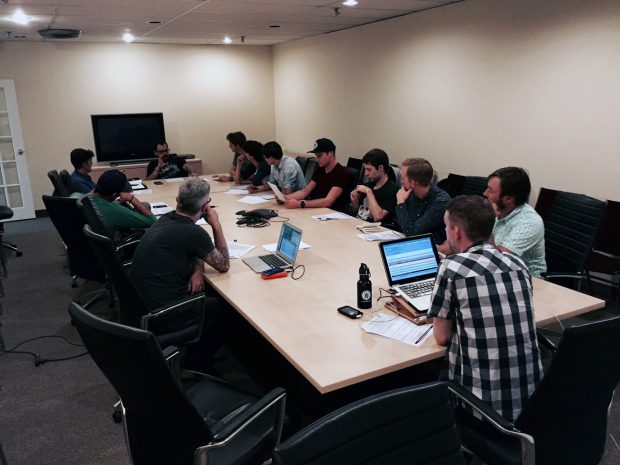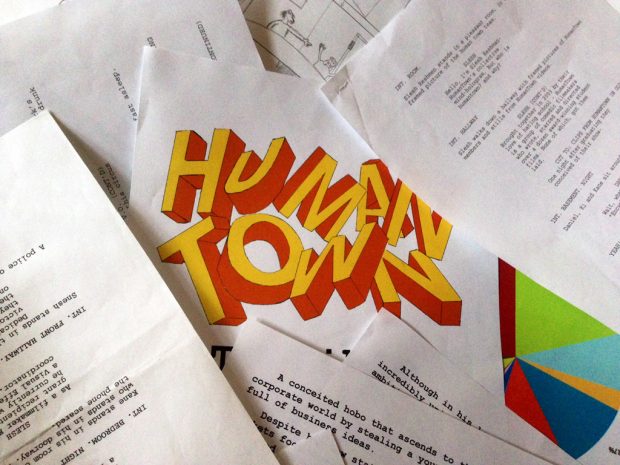
26 Jul A TV Comedy Writer Explains What Marketers Get Wrong About Brainstorms
By James Mulvey
During normal business hours, Liam MacLeod works quietly in Hootsuite’s creative department. He edits videos. Drinks a lot of black coffee. And attends Hootsuite’s marketing brainstorms.
In his spare time, though, he’s also managed to co-write a TV comedy show. Last year, his comedy team—a group of six high school friends—won $500,000 in production financing from the CBC, Canada’s national public television network. The TV pilot for their sketch comedy HumanTown airs to a national audience on Tuesday, July 26, 2016, at 9:30 p.m. in each timezone. It will be available to stream from 9:30 p.m. EST onwards.
MacLeod has been in two different types of brainstorms: a typical marketing brainstorm and late-night comedy writing sessions.
I wanted to know: what’s the difference between marketing brainstorms and comedy brainstorms?
Marketing vs. comedy brainstorms
How do comedy writers come up with those bizarre, creative, and funny concepts? Do they have a better process than marketing departments and ad agencies?
“The biggest mistake most marketing brainstorms make is that people don’t listen to each other,” says MacLeod. “Everyone is talking at once and trying to get their idea heard. In most marketing brainstorms there’s a lot of noise and not a lot of actual thinking.”
HumanTown’s writing team also struggled with this in the beginning. Over the years, they’ve learned to divide writing sessions into three stages:
- Silence and thinking
- Sharing ideas
- Collaboration
The thinking period in a comedy brainstorm begins with a writing prompt and two minutes of silence, explains MacLeod: “For us, when we’re writing a script, when we’re coming up with the idea for an episode or a scene, we like to start with a keyword like ‘restaurant’ or ‘first date.’ This is the writing prompt.
“We then set a timer for two minutes and all sit in silence, thinking on that prompt. The timer, we find, is really useful in giving everyone a set amount of time to think.”
When the timer rings, one person goes through their list of ideas. The majority of the ideas at this stage are mediocre. But going around the room one-by-one ensures everyone has a chance to be heard and that everyone is listening to one another.

“In your typical company brainstorm, there’s pressure to perform. Especially at ad agencies—everyone wants to be seen as someone who can come up ideas. So often the loudest voices end up on the whiteboard,” says MacLeod.
“We find that by the time we go around the room, new ideas are starting to form. For example, you might have meant one thing—but it sparked a different direction for me. So you’re getting a new synthesis of all those initial ideas. This is where you break into more creative ideas.”
Once everyone in the room has had a chance to share their ideas, the brainstorm enters the collaborative phase. “It’s speed thinking at this point,” says MacLeod. “A lot of ideas are going to be dumb. But you need that quantity. I’d rather leave a brainstorm with 20 ideas rather than three or four.”
Sorting the good from the mediocre is simple: “Typically, if you say something and everyone in the group starts to add things and run with the idea, it’s usually original. Those are the moments you need to look for. Even if it is a stupid idea, but gets people talking and laughing together—that’s what you want to look for. This is why listening is important. You want the group to take an idea and add to it and get the group thinking together.”
Once the brainstorm is over, MacLeod’s team books some solo concepting time. “I do this at Hootsuite as well,” he says. “Typically, a brainstorm is high pressure. There’s a deadline and pressure to show something to our boss, so doing a follow-up solo brainstorm can help. It’s a relaxed space where you can process the group’s raw material and refine it alone.”
MacLeod prefers to leave his computer behind when solo concepting: “Computers are dangerous. I prefer a notebook. It forces you to think. For example, you could spend 30 minutes searching Google Images for a prompt and have nothing to show. Also, looking up past campaigns or jokes can lead to unoriginal ideas. You might accidentally steal something.”
As with most TV shows, at HumanTown one writer is assigned to take a stab at the first draft. “We let one person go and do the actual writing. So it’s generally one person writing the script. If you have four people writing the same script, it’s not a good idea. It’s standard in TV for one writer to do a draft. They bring the draft back. And then another writer might take that draft away and come back with a second draft.”
The writer then returns and the team will do a reading of the scene. They’ll act it out and see how it sounds aloud. If needed, a new writer might take the draft away for a second (or third) rewrite.

Like any creative team, they need to get approval. For any creative who has worked in-house or at an ad agency, this can be the most difficult part of the creative process. This tension between creatives and stakeholders, says MacLeod, is still present even when writing for a TV show. “This will be a battle till the end of time. It’s as true in TV writing as in marketing departments.”
But MacLeod says that building trust can win approval for risky ideas: “There was one scene that we really believed in, but our producers didn’t think it would work. So we filmed the scene on our phones. We acted it out and showed how it would look. This helped them picture it better. So try to show the idea—help them visualize it.”
Creatives also need to compromise: “You need to trust their judgment too,” says MacLeod. “Sometimes, letting a few of our ideas die might have been for the best. Who knows. But you need to fight for the ones you believe in.”
Challenging stakeholders isn’t about ego; it’s a professional duty. “You’ve been hired to represent the creative side of things. It’s your job to let them know why something will work. So anything you can do to show it will work can help.”
I asked MacLeod for some final advice for all the creatives out there trying to improve their brainstorms.
“A lot of your ideas are going to be stupid. In an ad agency, you might hold back those ideas because you don’t want to seem dumb or off-brand to your boss. But a bad idea might mean something else to another person in the room. So don’t hold back your bad jokes. Share those silly ideas. Embarrass yourself.” View Full Article >>




Sorry, the comment form is closed at this time.